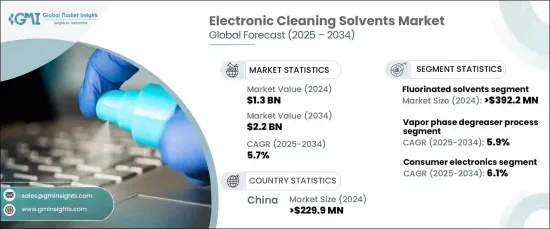
세계 일렉트로닉스용 세정 용제 시장은 2024년에 13억 달러에 달했고, 2025년부터 2034년까지 5.7%의 연평균 복합 성장률(CAGR)로 성장할 전망입니다.
이 시장을 주도하는 것은 다양한 산업 분야에서 효율적인 세정 솔루션에 대한 요구가 증가하고 있기 때문입니다. 이러한 용매는 그리스, 먼지, 솔더 플럭스 및 기타 오염 물질을 효과적으로 제거하기 때문에 전자 부품의 성능 유지에 필수적입니다. 첨단 전자 장비에 대한 수요가 증가함에 따라, 세정 용매는 복잡한 부품의 수명과 기능을 보장하는 데 필수적인 요소로 자리 잡았습니다.

자동차, 통신, 의료기기, 산업 장비와 같은 산업은 이러한 세정 용매에 크게 의존하고 있습니다. 또한, 지속 가능한 관행의 추진과 함께 세정 기술의 혁신이 시장의 성장 궤도에 큰 영향을 미치고 있습니다. 유해 화학물질 사용을 줄이기 위한 환경 규제는 친환경 대체품 개발에 박차를 가하고 있습니다. 특히, 수성 용매와 불소계 용매는 환경에 미치는 영향을 줄이면서 높은 성능을 발휘하기 때문에 인기가 높아지고 있습니다. 헬스케어, 통신 등의 분야에서 정밀 세정에 대한 요구가 증가함에 따라 전자 세척 용매 시장은 향후 10년간 크게 성장할 것으로 예상됩니다.
| 시장 범위 | |
|---|---|
| 시작 연도 | 2024년 |
| 예측 연도 | 2025-2034년 |
| 시작 금액 | 13억 달러 |
| 예상 금액 | 22억 달러 |
| CAGR | 5.7% |
불소계 용매는 2024년 시장 규모가 3억 9,220만 달러에 달했고, 2025-2034년 연평균 6%의 성장률을 나타낼 것으로 예상됩니다. 불소계 용매는 특히 섬세한 부품에서 오일, 플럭스 잔여물, 그리스를 제거하는 데 탁월한 세정력을 발휘하는 것으로 알려져 있습니다. 항공우주 및 통신 등의 산업에서는 유해한 잔류물을 남기지 않고 세척할 수 있는 불소계 용매를 선호합니다. 불소계 용매는 가격이 비싸지만, 효율성과 환경에 미치는 영향이 적기 때문에 특히 환경 규제가 강화되면서 불소계 용매를 선호하고 있습니다.
기체 탈지 공정은 2024년 3억 9,190만 달러의 매출을 창출할 것으로 예상되는 주요 부문입니다. 이 세척 방법은 폐쇄 루프 시스템에서 가열된 용매를 사용하여 증기를 부품에 응축시켜 손상 없이 오염 물질을 효과적으로 제거합니다. 이 공정은 복잡한 형상을 세척하고 용제 낭비를 최소화하는 능력으로 특히 높은 평가를 받고 있습니다. 기체상 탈지에 대한 수요는 항공우주 및 의료기기 제조와 같이 정밀하고 고품질의 세척이 필요한 산업에서 채택이 증가함에 따라 2025년부터 2034년까지 연평균 복합 성장률(CAGR) 5.9%로 성장할 것으로 예상됩니다.
소비자 가전 분야는 2024년 3억 9,310만 달러로 가장 큰 시장 점유율을 차지할 것으로 예상됩니다. 이 분야는 2034년까지 연평균 복합 성장률(CAGR) 6.1%로 성장할 것으로 예상됩니다. 소비자 전자제품이 고도화됨에 따라 고성능 세척 솔루션의 필요성이 점점 더 중요해지고 있습니다. 이러한 기기들은 기능성과 수명을 보장하기 위해 세심한 세척이 필요하며, 이는 전자 세척 용매에 대한 수요를 주도하고 있습니다.
아시아태평양에서는 중국이 시장을 주도하고 있으며, 2024년 시장 규모는 2억 2,990만 달러 이상에 달할 것으로 예상됩니다. 중국은 2034년까지 연평균 4.5%의 성장률을 유지할 것으로 예상됩니다. 중국의 전자제품 제조에 대한 우위와 지속가능성에 대한 관심이 높아짐에 따라 중국은 전자 세정 용매 세계 시장에서 선두를 차지하고 있습니다.
The Global Electronic Cleaning Solvents Market was valued at USD 1.3 billion in 2024 and is projected to grow at a CAGR of 5.7% from 2025 to 2034. This market is driven by the increasing need for efficient cleaning solutions across various industries. These solvents are essential for maintaining the performance of electronic components, as they effectively eliminate contaminants such as grease, dirt, and solder flux. As the demand for advanced electronic devices rises, cleaning solutions are vital to ensuring the longevity and functionality of intricate components.

Industries such as automotive, telecommunications, medical devices, and industrial equipment rely heavily on these cleaning products. Moreover, innovations in cleaning technology, alongside the push for sustainable practices, are significantly influencing the market's growth trajectory. Environmental regulations aimed at reducing the use of hazardous chemicals are spurring the development of eco-friendly alternatives. In particular, aqueous-based and fluorinated solvents are becoming increasingly popular as they offer high performance with less environmental impact. As the need for precise cleaning grows across sectors such as healthcare and telecommunications, the market for electronic cleaning solvents is expected to expand significantly over the next decade.
| Market Scope | |
|---|---|
| Start Year | 2024 |
| Forecast Year | 2025-2034 |
| Start Value | $1.3 Billion |
| Forecast Value | $2.2 Billion |
| CAGR | 5.7% |
Fluorinated solvents, which represented over USD 392.2 million in market value in 2024, are set to experience a growth rate of 6% CAGR from 2025 to 2034. These solvents are known for their superior cleaning power, especially in the removal of oils, flux residues, and grease from delicate components. Industries such as aerospace and telecommunications have shown a strong preference for fluorinated solvents due to their ability to clean without leaving harmful residues. While these solvents can be more expensive, their efficiency and low environmental impact make them a popular choice, particularly as companies adhere to stricter environmental regulations.
The vapor phase degreasing process is another dominant segment, generating USD 391.9 million in 2024. This cleaning method uses heated solvents in a closed-loop system, which condenses vapor onto components, effectively removing contaminants without causing damage. The process is particularly valued for its ability to clean complex shapes and minimize solvent waste. The demand for vapor phase degreasing is expected to grow at a CAGR of 5.9% from 2025 to 2034 as industries requiring precise and high-quality cleaning, such as aerospace and medical device manufacturing, increasingly adopt it.
The consumer electronics sector holds the largest share of the market, accounting for USD 393.1 million in 2024. This segment is forecasted to grow at a CAGR of 6.1% through 2034. As consumer electronics become more advanced, the need for high-performance cleaning solutions is becoming more crucial. These devices require meticulous cleaning to ensure functionality and longevity, driving demand for electronic cleaning solvents.
In the Asia Pacific region, China leads the market, with a value of over USD 229.9 million in 2024. The country is expected to maintain a 4.5% CAGR through 2034. China's dominance in electronics manufacturing, coupled with its growing focus on sustainability, has made it a key player in the global market for electronic cleaning solvents.